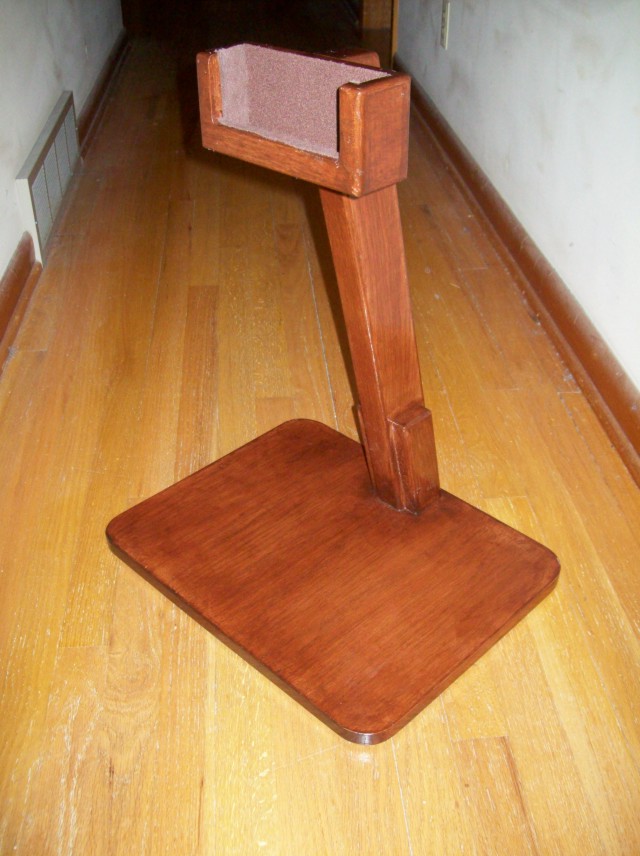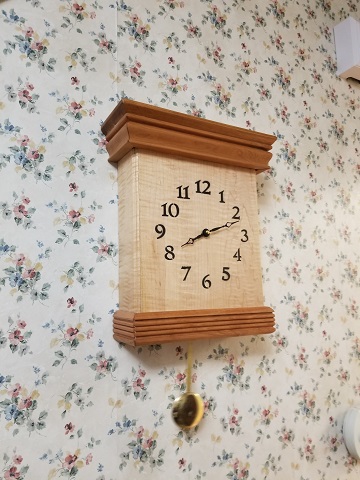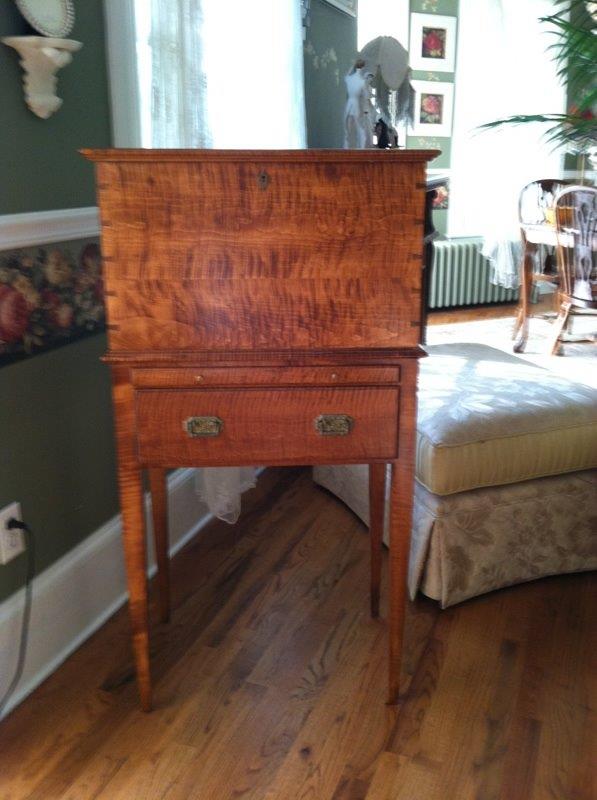Woodworking for the Blind
Woodworking for the Blind


This is a stand for an Intel digital reader for blind and low vision persons. The base of the stand is a piece of oak faced 3/4 inch plywood 18 by 14 and a half inches. The corners have been rounded off with approximately a one and a half inch radius. The vertical piece that supports the camera holder is made of two pieces of 3/4 oak that were ripped down to 2 and 3/4 inches and glued together. The bottom was cut off at an angle of 14 degrees to place the camera holder over the center of the sheet. The other end of the vertical piece was cut at an angle of 76 degrees to give it a vertical face to which to fasten the camera holder. The vertical piece was fastened to the plywood sheet with pocket hole screws, two on each side. The screw holes were covered with two pieces of 3/4 inch oak that were ripped down to 2 inches wide. They are approximately 6 inches long. Both ends were cut at 14 degrees so the top edge of these decorative pieces are parallel to the base. The camera holder was made out of 1/2 inch oak which I had to buy. A groove was routed in the inside near the bottom of each piece to hold a 1/4 inch bottom piece. Much of this piece had to be drilled and chiseled away to allow the lens, laser, and flash, to see out of the bottom of the holder. There are also cooling vents, a USB plug for a thumb drive, a small USB for connection to a computer, and a place to plug in the charger. All edges, except the plywood, were eased using a round over bit in the router table. The plywood was edged with iron-on oak veneer. The wood in Ron's house is dark so I finished it with a varnish stain combination. Water born poly urethane and dark walnut stain.

This is a group photo of the six boxes submitted to our small box challenge.

Post Office Bank by Dennis Walker The box is a Post Office bank. It is 4” wide x 4” deep and 6” tall. It is made of Red oak and has a coin slot cut in the top. The sides and back are joined by lock miters. It has a real ventage brass Post office box door on the front with a combination lock.

Small keep sake box by Scott Wheat Box is approx. 6” long x 4” wide and 3” tall. It is made of Hickory. Stock is ½” thick. It has a fitted removable lid. The lid has a ½” rabbit all around. This is Scott's first project.

Small box challenge advanced class first runner up. Box is approx. 8” long x 4.5” wide x 1.75” tall. sides are ¼” thick and the top is 3/8” thick. It is made of quarter sawn oak and has finger joint corners and a fitted removable lid.

This box is for holding a deck of braille playing cards. It is made of Sycamore. It measures approx. 4.5” long x 3” wide and 2” tall. It is hard to describe. There are two halves which are reverse images of each other. These two halfs slide together to give an appearance of one solid box. When taken apart it provides finger areas to pick up the cards and the top can be turned over to hold the discard pile.

The box is approx. 9.5” long x 3” wide and 2” tall and the wood is 3/16” thick. The sides are possibly Brown Heart, and the top and bottom is Zebra wood. The top slides off in the long direction. There is a 1/8” dado around 3 sides on the inside. One of the ends is ¼” shorter. The top is 3/16” thick with a 1/16” rabbit around 3 sides. The top slides in the dado slots. The lid is slightly longer with a small lip to use as a finger pull.
This is a small jewelry box. The box is made of cherry, and is approx. 8” long 4.5” wide and 4” high and the stock is 3/8” thick. It is joined by through dovetail corners, removable fitted lid with Mini roman ogee profile around the top. It has a ring tray at the bottom and a 6 compartment removable tray at the top.

This is a West Minster pendulum chime clock made of cherry and western curly maple wood. It is about 19 inches tall, 12 inches wide and 4 inches deep. The piece of western curly maple used for the clock face is a beautiful piece of wood because it shows 3 distingue grain patterns in the same piece of wood. The top left has a curly figured grain; the bottom right displays a quilted grain pattern and the bottom left shows birds-eye grain patterns.


This unit is a sugar chest and is called so because in the 1700's, in the south, it was used to actually hold sugar and possibly other spices. Made of quarter sawn Maple.